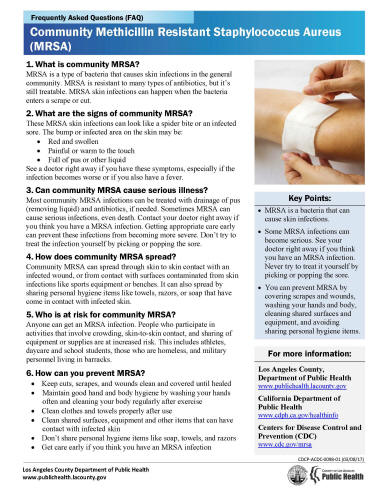"Staph" or Community-Associated Methicillin-Resistant
Staphylococcus aureus (CA-MRSA) Information
Staphylococcus aureus, commonly referred to as “Staph,” are bacteria found in the nose
or skin. Staph are the most common cause of skin infections. Some Staph have developed
resistance to the most common family of antibiotics that treat skin and blood infections.
These Staph are called methicillin (antibiotic)-resistant
Staphylococcus aureus (MRSA).
MRSA infections are common in hospitals and other healthcare settings, like dialysis centers
or nursing homes. MRSA infections in hospitals often affect the very old and the very young
or the very sick. However, recently MRSA infections have been found in healthy people outside
of the hospital. Most of these MRSA infections are found in the skin and soft-tissue (muscle,
fascia, fat). Since they occur in people in the community, they are referred to as
community-associated MRSA (or CAMRSA) infections.

CAMRSA is clinically and genetically different from MRSA infections that people acquire in
healthcare settings. The information below should help consumers and healthcare professionals
understand CAMRSA as a new and emerging disease.
People in Los Angeles County, the United States and around the world are getting skin
infections caused by community-associated methicillin-resistant
Staphylococcus aureus
(CA-MRSA). The Los Angeles County Department of Health Services, Public Health, is working with the public, doctors, and nurses to understand why these Staph/CA-MRSA skin infections are occurring and how to prevent them from spreading.
MRSA Frequently Asked Questions
English
Spanish
News & Updates
Myths & Misdiagnosis as Spider Bites
CA-MRSA has commonly been misdiagnosed as spider bites in LA County.
The true facts about spiders and spider bites are provided.
Resources
-
Staph & MRSA: Guidance
for Interim Housing Providers (July 2025)
-
Community Associated Methicillin-Resistant Staphylococcus Aureus:
an Emerging Infectious Disease in Los Angeles County
(The Public's Health, July/Aug 2005) Provides short
summary of disease burden and includes clinical, epidemiological and
laboratory hallmarks. Recommendations provided regarding treatment,
decolonization, education, infection control and notification.

-
Los Angeles County Department of Public Health Guidelines for Reducing the
Spread of Staph/CAMRSA in Non-Healthcare Settings
(September 2004) Prevention guidelines for those concerned
about the potential transmission of CAMRSA, i.e. proprietors of facilities
in which patrons and staff have bare skin contact with others or with shared
equipment or surfaces (e.g., gyms, health clubs, and spas), or where patrons
share close living spaces (e.g., homeless shelters, youth hostels, and camps).

-
QUESTIONS & ANSWERS: STAPH/MRSA SKIN INFECTIONS
(Jan. 14, 2004) Educational handout on CAMRSA for patients
and their families.

-
PREGUNTAS Y RESPUESTAS Infecciones de la Piel por Estafilococo Aureus
Resistentes a los Antibióticos
(Mar. 15, 2004)

-
Recommendations for Products to Effectively Disinfect Hands of MRSA
(MMWR, October 2002)

